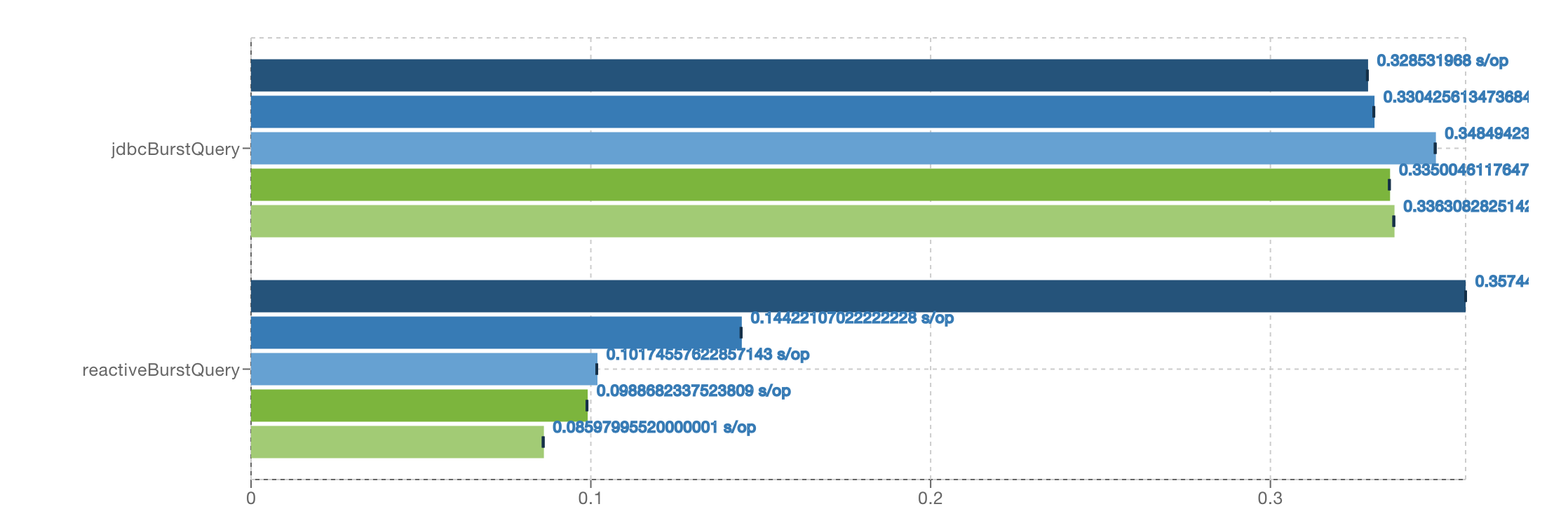-
Simple API focusing on scalability and low overhead.
-
Reactive and non blocking which able to handle many database connections with a single thread.
-
Ranked #1 in the TechEmpower Benchmark Round 15 Single query benchmark.
-
Event driven
-
Lightweight
-
Built-in connection pooling
-
Prepared queries caching
-
Publish / subscribe using Postgres
LISTEN/NOTIFY -
Batch and cursor support
-
Row streaming
-
java.util.stream.Collectorrow set transformation -
Command pipeling
-
RxJava 1 and RxJava 2
-
Direct memory to object without unnecessary copies
-
Java 8 Date and Time
-
SSL/TLS
-
Unix domain socket
-
HTTP/1.x CONNECT, SOCKS4a or SOCKS5 proxy
-
Request cancellation
Latest release is 0.11.2.
To use the client, add the following dependency to the dependencies section of your build descriptor:
-
Maven (in your
pom.xml) for Vert.x 3.6.x:
<dependency>
<groupId>io.reactiverse</groupId>
<artifactId>reactive-pg-client</artifactId>
<version>0.11.2</version>
</dependency>-
Gradle (in your
build.gradlefile) for Vert.x 3.6.x:
dependencies {
compile 'io.reactiverse:reactive-pg-client:0.11.2'
}If you are using Vertx 3.5.x you should use instead 0.10.9
Then the code is quite straightforward:
// Pool options
PgPoolOptions options = new PgPoolOptions()
.setPort(5432)
.setHost("the-host")
.setDatabase("the-db")
.setUser("user")
.setPassword("secret")
.setMaxSize(5);
// Create the client pool
PgPool client = PgClient.pool(options);
// A simple query
client.query("SELECT * FROM users WHERE id='julien'", ar -> {
if (ar.succeeded()) {
PgResult<Row> result = ar.result();
System.out.println("Got " + result.size() + " results ");
} else {
System.out.println("Failure: " + ar.cause().getMessage());
}
// Now close the pool
client.close();
});-
vertx-jooq: writing type safe queries and let them run at high speed using jOOQ, vertx and the reactive-pg-client.
-
Micronaut: supports reactive and non-blocking client to connect to Postgres using reactive-pg-client, allowing to handle many database connections with a single thread.
This client supports pipelining requests to the database which can give a significant performance improvement depending on the latency to the database and the type of queries your application is doing.
Such results have been produced using this benchmark.
|
Warning
|
The two results are not normalized, the 100µs latency executes the 5000 queries in about 300ms, the 1ms latency executes the 5000 queries in about 13 seconds. |
The Reactive Postgres Client currently supports the following data types
| _ | Value | Array | ||
|---|---|---|---|---|
Postgres |
Java |
Supported |
JAVA |
Supported |
|
|
✔ |
|
✔ |
|
|
✔ |
|
✔ |
|
|
✔ |
|
✔ |
|
|
✔ |
|
✔ |
|
|
✔ |
|
✔ |
|
|
✔ |
|
✔ |
|
|
✔ |
|
✔ |
|
|
✔ |
|
✔ |
|
|
✔ |
|
✔ |
|
|
✔ |
|
✔ |
|
|
✔ |
|
✔ |
|
|
✔ |
|
✕ |
|
|
✔ |
|
✕ |
|
|
✔ |
|
✕ |
|
|
✔ |
|
✔ |
|
|
✔ |
|
✔ |
|
|
✔ |
|
✔ |
|
|
✔ |
|
✔ |
|
|
✔ |
|
✔ |
|
|
✔ |
|
✔ |
|
|
✔ |
|
✔ |
|
|
✔ |
|
✔ |
|
|
✔ |
|
✔ |
|
|
✔ |
|
✔ |
|
|
✔ |
|
✔ |
|
|
✔ |
|
✔ |
|
|
✔ |
|
✔ |
|
|
✔ |
|
✔ |
|
|
✔ |
|
✔ |
|
|
✔ |
|
✔ |
|
|
✔ |
|
✔ |
|
|
✔ |
|
✔ |
|
|
✔ |
|
✔ |
The following types
MONEY, BIT, VARBIT, MACADDR, INET, CIDR, MACADDR8, XML, HSTORE, OID, VOID, TSQUERY, TSVECTOR
are not implemented yet (PR are welcome).
Snapshots are deploy in Sonatype OSS repository: https://oss.sonatype.org/content/repositories/snapshots/io/reactiverse/reactive-pg-client/
Out of the box, the test suite runs an embedded Postgres by default.
You can change the version of the embedded Postgres by passing a property embedded.postgres.version like this:
> mvn test -Dembedded.postgres.version=9.6The following versions of embedded Postgres are supported:
-
9.6 -
10.6(default) -
11.1(not supported on Linux)
You can run tests with an external database:
-
the script
docker/postgres/resources/create-postgres.sqlcreates the test data -
the
TLSTestexpects the database to be configured with SSL withdocker/postgres/resources/server.key/docker/postgres/resources/server.cert`
You need to add some properties for testing:
> mvn test -Dconnection.uri=postgres://$username:$password@$host:$port/$database -Dtls.connection.uri=postgres://$username:$password@$host:$port/$database -Dunix.socket.directory=$path-
connection.uri(mandatory): configure the client to connect the specified database
-
tls.connection.uri(mandatory): configure the client to run
TLSTestwith the specified Postgres with SSL enabled -
unix.socket.directory(optional): the single unix socket directory(multiple socket directories are not supported) to test Unix domain socket with a specified database, domain socket tests will be skipped if this property is not specified (Note: Make sure you can access the unix domain socket with this directory under your host machine)
-
unix.socket.port(optional): unix socket file is named
.s.PGSQL.nnnnandnnnnis the server’s port number, this property is mostly used when you test with Docker, when you publish your Postgres container port other than 5432 in your host but Postgres may actually listen on a different port in the container, you will then need this property to help you connect the Postgres with Unix domain socket
Run the Postgres containers with docker-compose:
> cd docker/postgres
> docker-compose up --build -VRun tests:
> mvn test -Dconnection.uri=postgres://$username:$password@$host:$port/$database -Dtls.connection.uri=postgres://$username:$password@$host:$port/$database -Dunix.socket.directory=$path -Dunix.socket.port=$portThe online and published documentation is in /docs and is served by GitHub pages with Jekyll.
You can find the actual guide source in [src/main/docs/index.md](src/main/docs/index.md). At compilation time, this
source generates the jekyll/guide/java/index.md.
The current documentation is in /jekyll and can be preview using Docker and your browser
-
generate the documentation
-
mvn compileto generatejekyll/guide/java/index.md -
mvn siteto generate the javadoc injekyll/apidocs
-
-
run Jekyll
-
cd jekyll -
docker-compose up
-
-
open your browser at http://localhost:4000

